 I’ve worn Threadless shirts almost exclusively since 2006. So I when I found out that their Art Director, Ross Zietz, was visiting Brisbane on Wednesday, 27th May as a guest speaker for the Portable Film Festival, I hooked up an interview with him for FourThousand. I researched like a good journalist and found that I owned two of his designs, ‘Pandamonium‘ and ‘Loch Ness Imposter‘. So I wore one of them when we met, to show that I’m a fan. Kind of like how gangs wear colours so that they know who not to fight.
I’ve worn Threadless shirts almost exclusively since 2006. So I when I found out that their Art Director, Ross Zietz, was visiting Brisbane on Wednesday, 27th May as a guest speaker for the Portable Film Festival, I hooked up an interview with him for FourThousand. I researched like a good journalist and found that I owned two of his designs, ‘Pandamonium‘ and ‘Loch Ness Imposter‘. So I wore one of them when we met, to show that I’m a fan. Kind of like how gangs wear colours so that they know who not to fight.
But Ross wouldn’t fight anyone. He’s a gentleman. He spoke with me about t-shirts for 45 minutes, before speaking about t-shirts for another 70 minutes to the Portable Film Festival symposium crowd of 40. During the discussion, Ross had to repeat answers to a lot of the questions that I’d asked beforehand. Poor guy.
A: Hey, Ross. I read that you joined Threadless as the janitor.
R: (laughs) Yeah, back in the day. Do you know that whole story?
A: Well I knew that you had submitted designs to the site. Then an opportunity came up at the company, and you took it.
R: Yeah. I went to school at Louisiana State University, and studied graphic design there. One day I was researching for a project at a bookstore, and there was a little blurb in a magazine about Threadless. So I checked the site out, and submitted a shirt that night. It was a really bad shirt, but I kinda just got hooked. It was a cool way to get feedback, and it was outside of what we had to do for school. It was like an escape, where I could just do what I wanted.
It was a year or two after that, right after I graduated from design school, when they posted a blog about how they were looking to hire somebody. It wasn’t for a graphic design position, it was for a – as they worded it – “helper dude”. I was about to accept a design position at a place in New Orleans, but I looked at the Threadless opp and thought – “why not?” Because I’d been to Chicago, and really liked it, and kind of wanted to get out of Louisiana as I’d been there all my life.
So I applied, and got an email back from Jake [Nickell, Threadless founder] the day after. He said that they were interested in hiring me, so they flew me out a couple of days later on St Patrick’s Day. The job interview was actually at a bar, and we drank some green beers. So I got the job the next day, and I was like, “All right! I guess I’m gonna move to Chicago!” I moved there the next month, and when I started there, I was like the ninth person that they’d hired. And I was probably the first person to join who wasn’t already a friend of Jake. Jake and Jacob [DeHart, Threadless co-founder] both had their own friends, and that’s how they brought the company together. That’s why everybody’s so close in the company. So I was one of the first that wasn’t part of the clique. At that time, we all packed and shipped shirts, and kind of did everything.
A: So Threadless had a warehouse space at that time, I take it.
R: We had a warehouse space, but it was like a quarter of the size that we have now. That’s when we were doing our early growing, I guess you could say. That was 2005.
A: So there were only nine people in 2005, and now you’re up to..
R: Around 80. 80 during the sales. We hire a bunch of temps to help us ship out shirts. And a lot of the time, the people who work as temps end up getting normal jobs, too.
A: When you applied, were Jake and Jacob aware of your design skills?
R: They were, yeah.
A: Had you had a few designs printed?
R: At that point I four or five printed. And that was one of my stipulations when they hired me. I told them that I really wanted to still be able to submit shirts. Because to me, it seems like if you work for the company, and you get chosen to be printed, it still kind of looks shady. So when I was hired, I started doing designs under different aliases. But yeah, that’s how I got the job!
A: Do you wear your own shirt designs?
R: I feel weird wearing stuff I designed. I don’t really own any of my designs. I let my mom, and dad, and girlfriend wear them, but I’d feel weird wearing them myself. Imagine if someone saw me wearing it, and came up to me: “Hey, you designed that shirt!” I don’t know if that’d really happen, but I’d just feel weird doing it.
A: But it’d be advertising for your work.
R: That’s true. If somebody was like, “Hey, I really like your shirt!” But that’s one of the great things about Threadless, when people say that kind of thing. Because we don’t brand it at all, so when people see the shirt and complement the design, that’s when you tell them about Threadless.
A: That’s the reason that I got into wearing Threadless. I used to wear surf brands and stuff when I was growing up, and I got sick of that. So I started wearing band shirts and Threadless. I found the site in 2006, and I really got into it, because I’d rather wear a cool design that I know someone made, rather than wearing a brand that I’ve never associated with.
R: Exactly. I think that’s really cool. Especially when the shirt designers are from all over the world. That’s really neat.
A: Does it still blow your mind to see people wearing your designs?
R: It does. The first time I saw someone wearing one of mine was ‘Pandamonium‘, and it was a girl at concert. I was with some friends, and they told me that I should go and talk to her.. because she was kind of cute too (laughs) But I didn’t do that, because I didn’t want to be like “Hey, I designed that shirt!”
A: “That thing you’re wearing? I made it!”
R: “I’m on your shirt tag!”
A: Really, man? I totally would approach people like that if I were you. It’d be a great introduction, because they’ve obviously taken the time to find your artwork, like it, and buy it. You’re too modest!
R: That’s true.
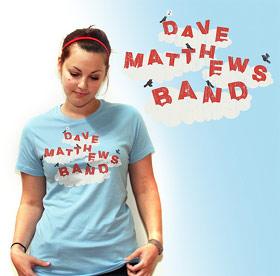 A: I saw that you’ve done some band work for Dashboard Confessional, Dave Matthews Band and a couple of others.
A: I saw that you’ve done some band work for Dashboard Confessional, Dave Matthews Band and a couple of others.
R: The first one I did was for Hellogoodbye. All of those artists, or their managers, saw my shirts on Theadless and got my email through the site. They said they liked my style, and asked if I’d be interested in doing some shirts for them. I was like, “Hell yeah!”. Because when you get a gig like that, it just seems awesome. It all happened though Threadless, and it happens with a lot of other designers. Once they get printed, and their name is out there and on the shirts. I know a bunch of others that’ve gotten to do shirts for bands. I know that Dave Matthews has done a bunch of Threadless designers. I’m actually doing some for Phish when I get back. That was through the Dave Matthews people.
A: Do they give you design briefs, or do they ask you to come up with something?
R: They tend to show me a bunch of stuff that they like, and have me go from there. It’s always interesting, because when you do a t-shirt for a big band like that, the most you’ll get paid is.. I did two shirts for Dashboard, and they paid me $1500 total. I thought that was a lot. But when you compare that to Threadless paying out up to $2200 for one design.. I know it seems strange to some people, but that is a lot of money for a non-spec work. And I know there’s no guarantee that you’re going to win, but at least you can have fun doing it.
A: Who would you most like to design a shirt for?
R: Doing something with a band who have a crazy, art attitude would be cool. Someone like Radiohead would be awesome. Any stuff like that where you can have more freedom. It’s fun doing that stuff; it’s fun to challenge yourself. I have no idea what I’m going to do for Phish. I’ve seen their older shirts that have fish smoking weed, but I’m going to try and come up with something cool. Right now, Patagonia is a company who I think is really cool. They’re kind of like an outdoorsy brand, and they’re really green and organic and all of that stuff. They’re based in Ventura, California, so they’re really into surfing and stuff. They work with some designers, like Geoff McFetridge, and I think it’d be really cool to design some stuff for them. I don’t think I could though, because I work for Threadless.
A: Do you get many bands approaching Threadless to do contract work through the site?
R: Yeah, we’ve done some Threadless Loves promotions.
A: I saw you had Hot Chip on there recently.
R: And a lot of other bands, like Josh Ritter and The Decemberists. I think we’re gonna start doing some more stuff like that, and maybe even do some bigger bands, too.
A: It sounds like a pretty good idea to me, for musicians. To source artwork from a crowd of people who’re likely fans of the act, in most cases. And if a fan’s artwork wins, they’ll tell all their friends about it.
R: Exactly. The bands that approach us are really cool about it, but the ones that aren’t cool about it are the ones that want the band’s name on the shirt. We haven’t really done a shirt with a band’s name. We run it so that the band will give a theme, and then the design community will take that theme and go nuts with it, and then the band will pick a winner.
A: I saw that Design By Humans have been doing that a lot lately.
R: Yeah. I’m not going to talk shit about them. They go through one merch company that uses a kinda weird licensing thing. But they do a lot of huge bands.
A: Fleetwood Mac, Kings Of Leon.
 R: Lil Wayne, too. It’s cool, but I didn’t like the shirts that got chosen. They got some amazing subs [submissions], but again, those artists require that the band name has to be pretty prominent on the design. It’s not to say that we wouldn’t do that in the future, but I think that we like it so that when you see the shirt, you think of the band, but it’s not necessarily overt.
R: Lil Wayne, too. It’s cool, but I didn’t like the shirts that got chosen. They got some amazing subs [submissions], but again, those artists require that the band name has to be pretty prominent on the design. It’s not to say that we wouldn’t do that in the future, but I think that we like it so that when you see the shirt, you think of the band, but it’s not necessarily overt.
A: You take more of a subtle approach.
R: Yeah, that’s it. Subtlety!
A: I guess that’s something that not a lot of artists would be down with that.
R: Yeah. That’s why the artists that we partner with are more into the whole ‘art scene’, I guess.
A: So you score a lot of designs each day. How long does it take you to know if you like a design?
R: I think it’s cool if when you see a t-shirt, and you don’t have to get it right away. When you walk by somebody, you usually see it for like two or three seconds. So it needs to be something that’s pretty simple and straight-forward. That’s just what I like, or whether it looks good or pretty. But the ones that are really intricate – the ones you have to look at real close – I think they’re cool, but that’s kind of more stuff to hang on a wall, rather than to wear on a t-shirt.
A: That’s funny, because I told a friend of mine that I was doing this interview. She said that she thinks that she prefers plain shirts to any kind of design. She thinks that designs just belong on walls, which I totally disagree with.
R: I guess I kinda see that, because I wear a lot of plain t-shirts too. I like the idea of being able to express yourself with a t-shirt.
A: Because a shirt is a statement.
R: Yeah. I like spicing it up a little bit, rather than wearing the same plain, uniform kind of shirts each day. It keeps people different, I guess. I do love some shirts that are really crazy, but I like simple stuff. My favourite artist is Geoff McFetridge. Do you know who that is?
A: No.
R: He’s pretty amazing. He does a lot of real simple, kinda goofy stuff, but I’ve always been a fan of his. Check him out – he actually just did a Select shirt for us [‘Frowns Are Flesh’, pictured below right]. That was pretty damn amazing – this guy, who I’ve idolised for so long, did a shirt for us. That was cool.
A: I’ve noticed that most Threadless shirts over the years have relied on a centre image on the chest, whereas elsewhere there’s a bit of a trend to use the whole shirt.
R: Yeah. We do that [giant designs] more now. Our best-selling shirts lately have been the all-over prints. One thing that I really like about Threadless is that we print enough shirts that there’s a range. I don’t mean to put down Design By Humans, but it seems like their shtick lately is just kinda giant prints.
A: Definitely.
R: It’s almost too much, and I think it alienates some people. It’s kinda cool that we can spread out. This [points to shirt – ‘Party Animal‘ by John Hegquist] is a new one. Just a real basic, simple print on the front. But we’re working all these new printers now, too, that have presses that can do these crazy big prints. But there’s not many in the Midwest. We’re based in Chicago; they’re more in LA, which is where Design By Humans is located.
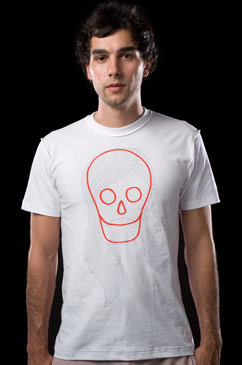 A: American Apparel are there too, aren’t they?
A: American Apparel are there too, aren’t they?
R: Yeah. They’re the ones that make our shirts. But we use two printers out of Chicago, and one of them is getting a brand new giant press, so we’re looking forward to seeing what we can do with that. But lately we’ve been doing more big prints, because that seems to be the trend that’s been coming for three or four years now.
A: Do you think that centre, chest designs kind of define Threadless’ style? Because when I think of Threadless, I think of the simple, character-based shirts, or the clever situations.
R: In the past, yeah, but I think we’re doing a bunch more random stuff now. If you look at our homepage, you can see that a lot of our new ones are trending toward giant prints. And another cool thing that we do is the Bestees, where you can vote on the best t-shirt that we print each month, and the winning designer will get another $2,500.
A: Oh yeah, I heard about that. That’s ridiculous!
R: It’s crazy. Three out of the three that’ve won so far this year are giant tees. [he shows me on his laptop]
A: Oh yeah, that red one is awesome. [‘The Red‘ by Dina Prasetyawan]
R: Yeah, these big prints are all the rage right now. And I think they’re cool, but I like simpler stuff.
A: Do your designs have a particular style?
R: I don’t really have a style. When I come up with something in my head, I have to make it look like that. And I think that is probably one of my problems, that I don’t have a distinctive style. I’m more about the idea than having a style. But no, I’m styleless. (laughs)
A: I’ve seen your stuff, and it’s pretty varied. You range from character-based ones like this, to ones like ‘Infinity MPG’.
R: I found out that one [‘Infinity MPG‘, pictured below] just got ripped, actually. I don’t know why I’m mentioning this, you probably don’t care.
A: No I do, because I saw that ‘Pandamonium‘ got kinda ripped off a while ago too.
R: They basically just stole the idea and made another shirt called ‘Infinity MPG’. And I was like, “oh well”.
 A: How do you feel about that?
A: How do you feel about that?
R: It sucks.
A: I guess there’s a good way to look at it – it was such a good idea that they wanted to take it off..
R: It’s kind of flattering, yeah. There are even people who started a website called ‘Infinity MPG’ after I got printed, and sold bumper stickers and all these things. It’s not like I invented the idea that by riding a bike you use less gas. (laughs) I can’t get mad at that. I think it’s cool. As long as it does something beneficial, it’s cool.
A: When people submit to Threadless, they still own the copyright of the image, don’t they?
R: The only thing we get is garment rights. So basically, we can put it on a t-shirt, or a hoodie. But the artist can make prints of the design and whatever else. We have some wall rights for wall graphics. We work with a company called Blik, and they do crazy wall coverings. They’re a great company to work with, and that’s why we have some of those rights.
But there’s been times when people have had their design printed on a shirt, and they came back to me saying “hey, I want to do something with this design”, like making a print out of it. We just talk to the artist and they’re fine with it. That’s the cool thing about being so close with all the artists. If they have a want or a need, they can just talk to us, and make it happen.
A: Here in Australia – and I’m sure you’ve heard of similar things in the US – I saw some designs for sale at a music festival market stall, and the majority of the shirts were Threadless rip-offs.
R: They were telling me about this yesterday in Melbourne, too. I have heard that. There’s a lot of places in Asia that have that same thing. And we can’t really do anything about it. It’s so hard to do stuff outside of the United States with that kind of law. And especially if it’s just at a market. Were the shirts tagged and everything? Did it seem like a legit brand, or like they weren’t making too many of them?
A: No, they just seemed like limited runs.
R: Yeah, see, it sucks, but we can’t really do anything about. It sucks for the artist, too, because they feel like they’re getting exploited more than we are, because they’re not getting any credit for it.
A: For sure. What’s the most important part of running an online design community?
R: I like being open and honest. When we fuck up, we let people know that we messed up. We keep our community ‘in the loop’, and that’s what is most important. I also like being able to be close with the designers. In my position as Art Director, I receive their art, and I get to work with these amazing artists to try and make what they envisioned work on a shirt. And at the same time, if the community sees something like a fake Threadless shirt, they’ll blog about it and kind of police for us.
A: It really is just a dedicated community built around t-shirts.
R: I know, and who would have thought? And seriously, when Jake came up with the idea, he never, ever in his wildest dreams thought that it would get as big as it has. The growth was organic, and it’s just turned out really cool.
 A: Tell me about the Threadless retail stores.
A: Tell me about the Threadless retail stores.
R: We have two now. They’re both in Chicago. We opened the first one around 18 months ago, and then the second around six months ago. The second one was just for kids shirts, initially, but we’re going to change it so that it’s for both kids and adults.
A: So the kids idea didn’t work out so well?
R: Well it did, but parents would come in with their strollers and want to buy shirts for themselves, too. It makes sense to have everything there, rather than just do a kids store.
A: I read that the first store didn’t have a lot of stock, but tended to focus on art instead.
R: We tried to replicate the feeling you get when you’re on the website. We have a bunch of digital displays where you walk in, and you can get a headshot of yourself taken. We have a bunch of monitors on these mannequins in the window, so your head will show up on the mannequins.
A: Is that a popular feature?
R: Yeah, it’s pretty cool. It’s a pretty busy walking street, so a lot of people walk by and stuff. We do two weeks of stock at the store, so we only have like 18 shirts in the store at a time. I mean, right now we’ve had like 2,000 shirts printed, and in stock we have probably 300 designs, so we can’t necessarily have 300 designs in stock at the store. But it’s a pretty small little shop, and we just decided to do the most recent shirts, and cycle through.
A: Do you have plans to expand the store range?
R: Eventually, we’d love to. It’s just that right now, it’s just so hard with all of the money issues going on. But we definitely plan to do some more stuff overseas. And the cool thing is that Australia is our #4 country, sales-wise. It goes US, UK, Canada and Australia, so y’all are up there on our list. This is my first time here; it’s been great so far. I really love it!
A: The whirlwind tour – you’re here for what, three days?
R: I know! So quick. I was in Melbourne for the past two days and basically jetlagged the whole time. Tomorrow is Sydney, and then I have two days to relax. Actually, another Threadless guy is coming from New Zealand to meet me there. His girlfriend lives in Sydney, so we’re gonna hang out for those few days. He’s a cool guy. The community has these meet-ups once per year in Chicago, and we have designers and members from all over the world coming to meet us.
A: The online community in real life.
R: I know, it’s nuts. It’s nuts that they travel – well, not nuts – but it’s really cool that they travel that far just to come and meet everybody.
A: Dedication! Brand loyalty! Hey, how many votes does it to convince you that a shirt you don’t personally like should be printed?
R: We have a brand management team, and so when we look at the scores of shirts, we can see the highest scoring ones, but then we can break it down into how girls scored it, how guys scored it, how people that buy a lot of shirts scored it; all these different factors that we get to look at. That’s how we decide what gets printed. So there’s a lot of times where designs that I’m not really too keen on score amazingly, and I can’t deny it just because I don’t like it. If a lot of other people like it, it’s worth printing.
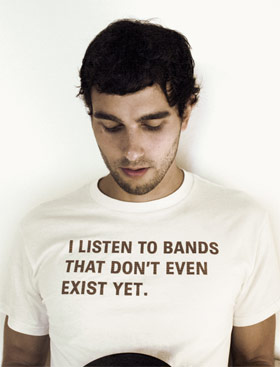 A: How many shirts does Threadless print per week?
A: How many shirts does Threadless print per week?
R: A single batch is right around 1,000. But before we print them, we ‘weigh in’ the amount of votes. So if it scored well with girls, we’ll print more for them, and if it didn’t score so well for guys, we’ll print less. One single batch is usually between 800 and 1,000. Once they sell out, you can request a reprint, and the artist will get another $500 if the shirt gets reprinted.
A: How many requests does it take for reprint?
R: It varies, but if we do a shirt that sells out really fast, we’ll push that to reprint a little bit quicker, especially if it’s like a hot topic, or a hot style at the time. But when we look at a reprint request, we usually get more than 2,000 requests before we reprint.
A: But you only print around 800 or a thousand at a time.
R: A lot of times when people make a reprint request, they’ll do it multiple times.
A: I guess that Jake and Jacob learned that the hard way.
R: Yeah. (laughs) And a lot of the time when people request a reprint, they changed their mind when it’s back up on the site.
A: The site has those $5-10 shirt sales throughout the year. Is that just to clear out the inventory?
R: Yeah, it’s to keep everything clean. We’re starting to have $9 shirts on the site almost all of the time, now, but we tend to only drop to $5 for the crazy sales. But we do that just because we release so many shirts a week that stuff gets lost of the site, if we don’t clear it out. Like if we printed more than 800-1,000 shirts, the different designs that we have would just get too much, and too hard for people to find on the site. And that’s another thing that’s really hard: a lot of the time, shirts have titles that don’t really fit, so when people are looking for it, it’s kind of hard.
A: Maybe that’s something that could be built into the site – shirt keywords.
R: We do some keywords, but it’s always hard to keep track of that.
A: I was submitting some photos on the site last week [note: uploading a photo of yourself wearing a Threadless shirt earns $1.50 in store credit] and it took me a while to figure out their names.
R: It’s tough. It’s one of the things that we’re constantly working on – better ways to keep it so that shirts don’t get lost. Some really great designs get lost on the site.
A: How did the Twitter tee range come about?
R: We have a pretty good relationship with the Twitter guys. Our Chief Technical Officer Harper Reed is friends with them. Twitter put us on their ‘suggested users’ list, and now we have over 500,000 followers. It’s crazy for a little t-shirt company out of Chicago.
A: It’s such a powerful medium when you have that kind of a follower base. Every time you post a link, it goes out to a huge amount of people.
R: That’s the thing. We’re trying to figure out the best way to use that. We don’t want to drive people crazy and post too much. We don’t want to be annoying. So we’re trying to figure out what people react to. Because, yeah, when you have half a million people following you, you have to think about everything that you’re sending out.
A: There’s guys like Trent Reznor who have a similar amount of followers. It’s the kind of thing that could be abused so easily. “With great power comes great responsibility.”
 R: Exactly.
R: Exactly.
A: Would you wear a Twitter shirt?
R: Um.. (pauses)
A: Come on!
R: I’m not a big ‘words on t-shirts’ kind of guy..
A: I didn’t think so!
R: Me and two other guys are designing all of those Twitter shirts, and all of the Type tees, but I like more of the subtle stuff. Less ‘in your face’. I wouldn’t be too fond of wearing the ‘I’m huge on Twitter‘ shirt. But there’s definitely an audience for that stuff. It’s just not my cup of tea. But we are going to start doing more Twitter shirts that are going to be less about Twitter, and more about funny things that people said on Twitter. I think that we probably shouldn’t have done the launch using four shirts about Twitter.
A: What can you recall about your first time on the site?
R: I remember that first night that I went on Threadless, I studied the site for a little bit, and studied the designs that had been submitted. And I came up with a design, and thought “man, this shirt is going to be so awesome!” It was a heart on a sleeve, and it was the worst design ever.
A: That was it? Just a plain shirt?
R: Yeah, a plain shirt with a heart on the sleeve. I was like, “That’s so clever and creative!” So I subbed that, and it just got tore up. It was hilarious. But that’s what got me hooked, because I was like, “All right, I’ll prove these guys wrong! I can do some stuff that they’ll like, that I’ll like too!” And that got me hooked. But the community can be brutal. They can be mean. If you put some stuff up that they don’t like, it can be a real reality check sometimes.
A: That’s a good thing though, right? You’d want criticism rather than praise?
R: Exactly. You want honest criticism. That’s one thing I noticed when I was in design school. Our teachers would give honest feedback, but the students would never really give feedback. They probably just felt that they were trying to say good stuff. And so when you put it online – especially with people you don’t know – and they give you feedback, that’s when you feel like you get more of the honest truth from people.
A: Was that hard to deal with at first, as an artist who’d been otherwise praised?
R: Yeah.. no.. (laughs) I think you need that. It’s what keeps you humble, and what keeps you in check. You don’t want to get a big head about anything.
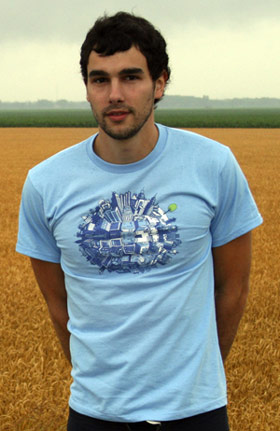 A: The site gets over a thousand subs per week – what percentage is printed?
A: The site gets over a thousand subs per week – what percentage is printed?
R: We’re printing six new sub shirts per week, and we’re about to add two more per week. So it’s less than a 1% chance of being printed.
A: But it’s not really chance, though.
R: Yeah, it’s more based on skill.
A: That’s the beauty of it: the most popular, or the best designs, will win.
R: That’s one of the things that’s tough, because I do feel like there is a little bit of a popularity contest within the community. It’s not as bad as it could be, but you do notice that people who score well tend to always score well. I mean, a lot of times it’s because all their stuff is so good, but other times they just figure out what people want and they just duplicate that style, to make it work on a t-shirt.
A: What’s your favourite printed Threadless design?
R: The one you’re wearing is pretty great [‘Pandamonium‘]. I also like ‘Loch Ness Imposter‘.
A: I’ve got that one too. It’s pretty subtle, it takes people a while to get it.
R: Yeah, it’s great. The one shirt that I designed that I wear is ‘Piece Of Meat‘, the one with just the steak on it. I don’t know why, I just really like that shirt. One of the shirts that I’ve been wearing a lot lately is a Select shirt that wasn’t even that popular, it’s a green one called ‘The Hills Have Eyes‘ [by Clayton Dixon]. It was like this little mountain scene with these hills that all have eyeballs, and this guy in a station wagon driving by. It was illustrated really well. It just looked cool on a t-shirt, and I liked the green colour. That’s the one I wear the most. [he points at a bowl of Smarties that I’ve been snacking on throughout the interview] Are these chocolate?
A: Yeah, they’re called Smarties. When you were at college, did you imagine that you’d make a living off of directing the art that appears on shirts?
R: No, not at all. I know that I basically just lucked out, and every day when I come into work, I think “this is an awesome job”. And now I get to come to Australia and talk about it!
A: Again, it wasn’t luck, though. You were chosen for this. It was perfect for you!
R: Yeah – it found me! (laughs) But no, it is really cool. When I was at college, I thought that I’d eventually get a job at a design firm or at an ad agency. Which still wouldn’t be bad, but it’s just that I like what I’m doing now.
A: What advice do you have for young designers?
R: Oh, man. (pauses)
A: Would you recommend following your path – not to become Threadless Art Director, but in terms of getting printed?
R: Do what you want. Do what you enjoy doing. I mean, for kids in school, it’s tough now, because you have to do these real strict assignments and stuff. But try and make each project your own, if you can. Use a grid. I love using a grid, even in strict illustrations, I’m real weird about that.
A: Can you explain that? I have no design knowledge. What’s the advantage of a grid?
R: It’s a sort of really anal thing, I guess. It’s a Swiss thing. But when you start working on a piece, imagine if there was like gridwork and lines going through it. If you can get ’em to match up and stuff, it’s a lot more pleasing to the eye, usually.
A: What, so being symmetrical?
R: Not symmetrical. Just – at points. It’s one of those weird things that I’ve always done. There are definitely design teachers who are like, “Break the grid. Don’t use a grid.” For illustrations, you don’t have to use a grid. But when you’re doing stuff with type, and type mixed with imagery, I think it’s important to have some structure to it. That was one of the first things that we learned in design school.
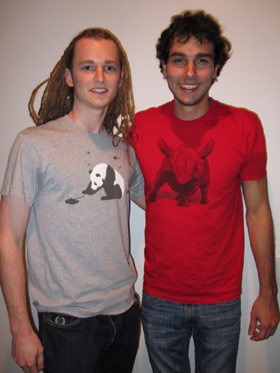 A:Tonight’s discussion [for the symposium] is a bit different to last night, right? I’m told that you’ll be speaking about the entrepreneurial side of things.
A:Tonight’s discussion [for the symposium] is a bit different to last night, right? I’m told that you’ll be speaking about the entrepreneurial side of things.
R: I think so. Which is not really my expertise, but..
A: You can bullshit, right?
R: I can do my best (laughs) But Portable [Film Festival], where Andrew [Apostola, Creative Director] works, they’re the ones that flew me out here. What we do with Threadless, they kind of do with films. They allow filmmakers that’re just getting started to get their films out there, so that people can see them. That’s kind of like how designers who’re just starting out can put their designs up on Threadless and get people talking about their work.
A: That’s gotta be one of the best parts of the internet, how people can group off in different sections and just talk amongst yourselves. People who care about a topic can find their own niche.
R: Exactly. All over the world. It’s really great.
Aww. Thanks again, Ross. That was probably my best interview so far. If you want, you can stalk Ross on Twitter, Flickr, and Threadless.
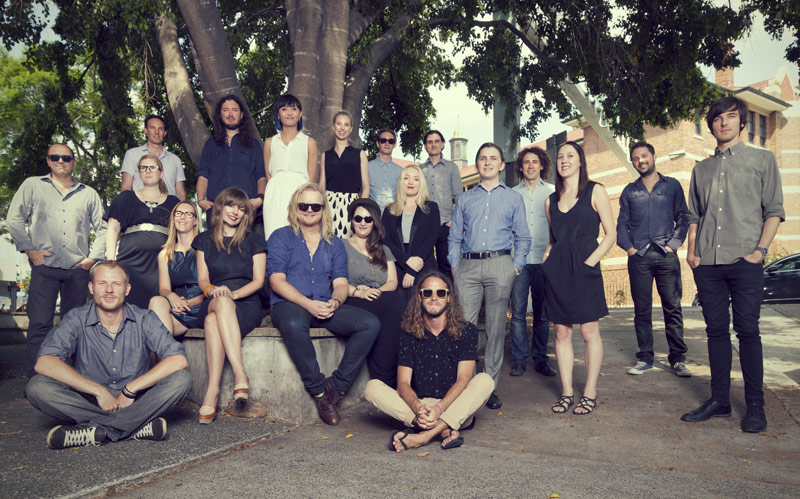
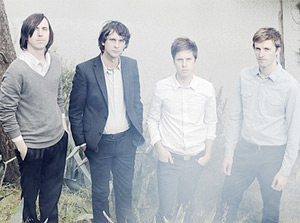
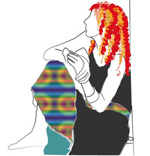 Play games. Read books. Watch movies. Understand your world, so that when you’ve learned some hands-on, practical skills, you have ideas to make new, exciting forms of games. Generate your own enthusiasm, and your own, new industry. Don’t go and be a little worker; go and make your own world. I think games are just beautiful. Design is powerful. Game design is utterly powerful. You’re playing with culture and philosophy and fun and image and audio; the whole kit and caboodle. Don’t just think about making new forms; think about pushing the boundaries with it.
Play games. Read books. Watch movies. Understand your world, so that when you’ve learned some hands-on, practical skills, you have ideas to make new, exciting forms of games. Generate your own enthusiasm, and your own, new industry. Don’t go and be a little worker; go and make your own world. I think games are just beautiful. Design is powerful. Game design is utterly powerful. You’re playing with culture and philosophy and fun and image and audio; the whole kit and caboodle. Don’t just think about making new forms; think about pushing the boundaries with it. One of the big things we look for when we’re interviewing people is their portfolio. Whether it be as an artist showing your work, or a programmer and having a playable game; that just puts you so far ahead of other people when you’re applying for a job. And even a designer, if you have a little walkthrough video. One of the guys we hired at Krome for Ty the Tasmanian Tiger 2 – Rob Davis, a graduate, who’s now working at Microsoft Games Studios in Seattle – he had a walkthrough of a Ty The Tasmanian Tiger level that just blew everyone else away. He’d thought about it, and made a level up. He couldn’t program, or really do art, but he did a simple little walkthrough video, and explained his thought processes. That was amazing. It gave him such competitive advantage.
One of the big things we look for when we’re interviewing people is their portfolio. Whether it be as an artist showing your work, or a programmer and having a playable game; that just puts you so far ahead of other people when you’re applying for a job. And even a designer, if you have a little walkthrough video. One of the guys we hired at Krome for Ty the Tasmanian Tiger 2 – Rob Davis, a graduate, who’s now working at Microsoft Games Studios in Seattle – he had a walkthrough of a Ty The Tasmanian Tiger level that just blew everyone else away. He’d thought about it, and made a level up. He couldn’t program, or really do art, but he did a simple little walkthrough video, and explained his thought processes. That was amazing. It gave him such competitive advantage.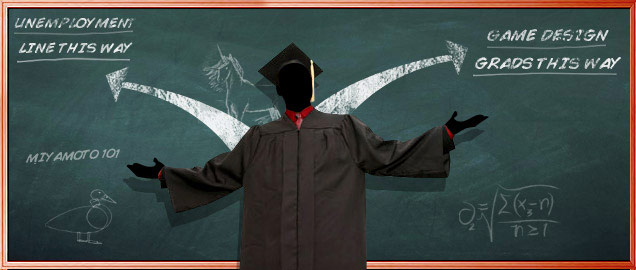
 I’ve worn
I’ve worn  A: I saw that you’ve done some band work for
A: I saw that you’ve done some band work for  R:
R:  A:
A:  A: How do you feel about that?
A: How do you feel about that? A: Tell me about the Threadless
A: Tell me about the Threadless A: How many shirts does Threadless print per week?
A: How many shirts does Threadless print per week? R: Exactly.
R: Exactly. A: The site gets over a thousand subs per week – what percentage is printed?
A: The site gets over a thousand subs per week – what percentage is printed? A:Tonight’s discussion [for the symposium] is a bit different to last night, right? I’m told that you’ll be speaking about the entrepreneurial side of things.
A:Tonight’s discussion [for the symposium] is a bit different to last night, right? I’m told that you’ll be speaking about the entrepreneurial side of things.